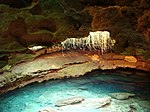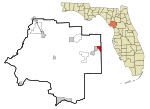Williston Municipal Airport
1942 establishments in FloridaAirports established in 1942Airports in FloridaTransportation buildings and structures in Levy County, FloridaWilliston, Florida
Williston Municipal Airport (FAA LID: X60) is a city-owned, public-use airport located two nautical miles (4 km) southwest of the central business district of Williston, a city in Levy County, Florida, United States. Commonly referred to as Williston Airport, it is located 23 miles (37 km) southwest of Gainesville Regional Airport (GNV). Opened in 1974 for public use, it does not have a control tower. This airport is included in the National Plan of Integrated Airport Systems for 2021–2025, which categorized it as a general aviation facility.Within 5 miles (8 km) of the airport are the internationally known dive springs of Devil's Den and Blue Grotto.
Excerpt from the Wikipedia article Williston Municipal Airport (License: CC BY-SA 3.0, Authors).Williston Municipal Airport
Southwest 19th Avenue,
Geographical coordinates (GPS) Address External links Nearby Places Show on map
Geographical coordinates (GPS)
| Latitude | Longitude |
|---|---|
| N 29.355833333333 ° | E -82.471944444444 ° |
Address
Williston Municipal Airport
Southwest 19th Avenue
32696
Florida, United States
Open on Google Maps





